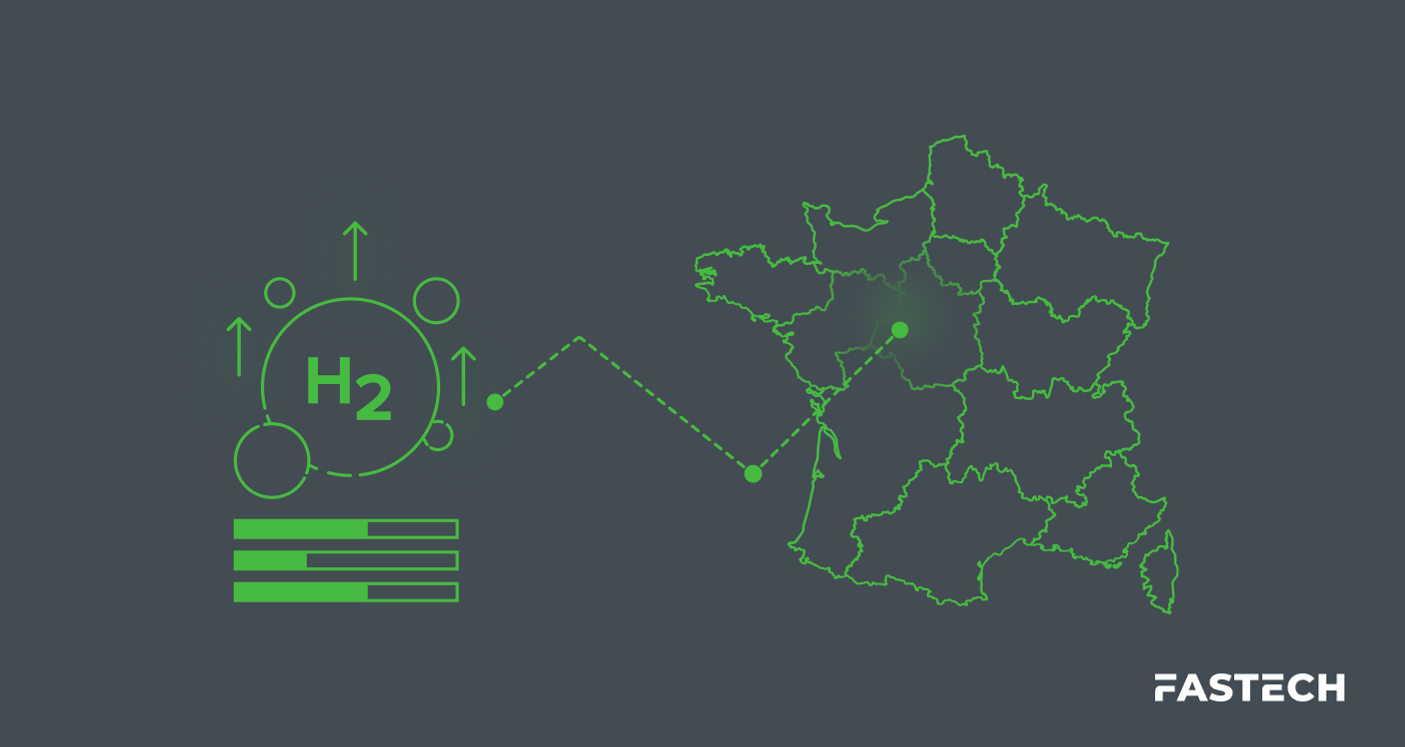Unlocking Sustainable AI Data Centers With Hydrogen

The rapid rise and adoption of artificial intelligence (AI) is accelerating energy demands in the data center industry.
Hyperscale cloud data centers are fast becoming the standard for providing the vast computational power and data storage needed to support deep learning models.
Simply put, one of the costs of AI innovation is enormous energy consumption.
But as traditional power grids struggle to keep pace with surging demand—and the world aims to decrease its carbon footprint—data center engineers are seeking clean, reliable alternatives.
A surprising hero has risen to the challenge of powering super-sized data centers: hydrogen fuel cells (HFCs).
Let’s explore how the world’s most technologically demanding industry is finding zero-emission solutions in the universe’s most abundant element.
The Rising Energy Demands of AI Data Centers
It’s tempting to think of AI and the internet as wireless, invisible, intangible forces of nature operating out of thin air. In reality, both live within the unassuming brick-and-mortar walls of data centers.
In many ways, AI data centers are much the same as their traditional counterparts. Their climate-controlled rooms hold rows of servers, routers, switches, firewalls, graphics processing units (GPUs), and application-delivery controllers.
This digital infrastructure runs on an uninterruptible power supply (UPS) regulated by power subsystems and kept within safe operating parameters by ventilation, cooling, and fire suppression systems—all to ensure seamless data service.
What sets AI centers apart is the sheer volume of their processing, storage, and energy needs. AI workloads would crash an unspecialized data center. It takes robust infrastructure to power the commercial-grade GPUs that drive machine learning.
The data center industry had already been evolving at breakneck speed before AI. As recently as 2010, around 80 percent of computation was performed in small centers, often run by non-tech companies. By 2018, as much as 89 percent had migrated to hyperscale cloud data models that have reigned supreme ever since.
As cloud-enabled AI services continue to soar in size and complexity, data center power demand is poised to grow 165 percent by 2030.
Hydrogen Fuel Cells (HFCs): Sustainable Energy Solutions
Though earning a smaller spotlight than AI, hydrogen fuel cell technology has made similarly exciting advancements in recent years.
HFCs generate power by catalyzing an electrochemical reaction between molecular hydrogen (H2) and oxygen (O2), producing only water and heat as byproducts. As such, hydrogen is a zero-emission source of electricity when processed through a fuel cell.
However, that’s not all hydrogen has under the hood. Here are other key attributes that set it apart from other renewables:
- Consistent availability: Hydrogen is naturally abundant in all environments, lending to diverse production methods.
- High energy efficiency: Hydrogen is highly energy-dense by mass, making every particle high-performance.
- Physical storage: Hydrogen is compatible with gaseous, liquid, and materials-based storage methods.
In short, hydrogen is widely available, highly powerful, and easier to store than electricity. Unlike batteries, fuel cells don’t degrade over daily cycles and can scale to multi-megawatts to support critical loads when needed.
These factors make HFCs a compelling choice for data centers seeking reliable, clean energy alternatives.
Current Hydrogen Implementations in Data Centers
Several initiatives by tech industry leaders have demonstrated hydrogen’s efficacy for powering data centers and transforming them into cleaner, more resilient facilities.
- Microsoft and Caterpillar tested hydrogen’s resilience in extreme conditions using a 1.5 MW Ballard HFC system for backup power at a Wyoming data center 6,086 ft above sea level. The trial yielded 48 hours of continuous operation in below-freezing conditions.
- ECL launched the first fully green, off-grid data center-as-a-service site, using HFCs as its primary energy source. The modular facility leases 1-MW blocks with 99.9999 percent uptime at a fraction of the cost of traditional colocation facilities.
- Plug Power forecasts a surge in demand for its green HFC backup systems coming from data centers in late 2025, citing the growing need for continuous power supplies in AI. The company is already collaborating with three major data center operators to plan initial deployments and test these carbon-neutral solutions.
These projects showcase hydrogen’s primary and backup power applications in demanding data center environments. With giants like Microsoft and Amazon exploring H2’s capabilities, others are sure to follow suit.
More importantly, these real-world implementations prove hydrogen’s viability for feeding energy-hungry AI sustainably.
Benefits of Hydrogen Energy for AI Data Centers
Despite its low media profile, hydrogen’s growing reputation as an energy source is centuries in the making.
Historically, HFCs have struggled with technological, infrastructural, and financial limitations that made them unfeasible for most applications.
However, recent advancements are bucking this trend and unlocking new alternatives for the world’s heaviest polluting and hardest to abate sectors.
Compared to its alternatives, hydrogen offers several advantages that address the unique demands of AI data centers:
- Lower emissions: Compared to diesel generators—which emit harmful particulate matter (PM), carbon monoxide (CO), nitrogen oxides (NOx), and black hydrocarbons (HC)—hydrogen fuel cells produce only water, heat, and clean electricity. Even when used in internal combustion engines (ICEs), hydrogen burns cleaner than its fossil-fueled counterparts.
- Energy independence: As demonstrated by ECL, hydrogen energy systems can operate completely off-grid. With options to produce hydrogen on-site or simply bring it in bulk, project managers can deploy HFC solutions in areas without traditional energy infrastructure. Self-sustaining operations are also less reliant on congested public utility networks, reducing delays in development.
- Operational efficiency: Compared to diesel generators, HFCs are simpler and cleaner to operate, leading to lower maintenance costs and complexity. Hydrogen refuel times are on par with those of fossil fuel counterparts (with the exception of delivery vessels that use pressure equalization techniques, which tend to take longer).
- Modular scalability: Fuel cell stacks offer precise customization options with room for growth. Though a single fuel cell generates only around one volt of electricity, big enough stacks can transform these cells into a body big enough to power buildings and heavy-duty industry. With a boundless range of options, HFC systems can be sized to match load requirements from kilowatts to multi-megawatts.
- Hot and cold integrations: Besides electricity, HFCs only produce heat and water vapor, which some facilities can reuse for greater efficiency. Combined heat and power (CHP) systems can channel the significant heat exhaust, while the water can be recycled for rack cooling. Both solutions can lower the data center’s energy load.
These benefits are uniquely well-suited for data center developers striving for operational resilience and sustainability.
Challenges and Considerations
Though HFCs may sound like an obvious choice by this point, there are some logistical roadblocks to hurdle:
- Initial costs: Because existing hydrogen infrastructure is sparse across the U.S., many who invest must build their local hydrogen economy from the ground up. Furthermore, hydrogen is incompatible with its alternatives’ fuel systems, requiring dedicated facilities, storage, and vehicles as a cost of entry. Hydrogen costs are expected to lower as the market grows in size and competition.
- Lifecycle emissions: Hydrogen is not created equal in terms of sustainability. While green and turquoise hydrogen are true net-zero fuel sources, the largest share of commercial hydrogen is sourced from natural gas, a fossil fuel. While electrolysis offers an affordable middle ground, the technology is expensive to scale. Data center developers will have to weigh lifecycle sustainability against financial feasibility.
- Storage logistics: Hydrogen has low volumetric density, meaning it needs to be compressed and consumed in bulk to yield real results. Gaseous hydrogen requires specialized storage tanks and fueling infrastructure, but nothing beyond what one might expect from CNG or propane. Liquid hydrogen—arguably the more cost- and operationally-efficient option— requires a pressurized environment, plus cryogenic cooling equipment (which comes with additional maintenance requirements). Materials-based storage through hydrogels or chemical carriers is a promising solution, but still in early research and not commercially available.
- Regulatory compliance: As a burgeoning energy source, once niche and experimental, hydrogen has little regulatory framework to guide its production, storage, or distribution. Rather than a sense of freedom, this policy ambiguity creates confusion that can dissuade potential investors. Recent policy progress includes the U.S. Treasury finalizing the Clean Hydrogen Production Tax Credit and the Federal Aviation Administration (FAA) releasing a roadmap for hydrogen-fueled aircraft regulation.
Potential Synergies Between AI and H2
Though hydrogen energy is poised to become a mainstream solution for AI data centers, the relationship could be a two-way street. AI’s pattern identification and analysis capabilities are advanced beyond human capabilities, making it extremely good at optimizing.
For example, an innovative project dubbed HyAI aims to leverage algorithmic machine learning to streamline hydrogen production and storage procedures based on historical and forecasted weather data. If trials are successful, the system is expected to be integrated into the developer's H2 production plant for real-world testing.
If an AI can optimize hydrogen supply chains, it will lower prices for producers and consumers, accelerating the roll-out by making new projects more budget-friendly.
There’s fair reason to believe in HyAI’s potential for success. As early as 2016, Google successfully leveraged DeepMind AI in its data centers, subsequently lowering energy consumption by 40 percent.
Making AI Data Centers Cleaner With Hydrogen Fuel Cells
HFCs represent a transformative energy opportunity for AI data centers and other demanding sectors.
As a clean, reliable, and scalable power source, hydrogen has shown potential for applications as widespread as power grid stabilization due to its innate workload capacity and battery-like energy storage features.
As the AI revolution drives energy demands alongside global consumption rates, data center sustainability may depend on hydrogen infrastructure.
FASTECH is the leading clean infrastructure partner for forward-thinking organizations seeking cleaner alternatives. Our turnkey EPC+M solutions have built over 40 hydrogen fuel stations, with hundreds of other custom projects delivered.
From hydrogen hubs to pipelines or light-duty fuel pumps—FASTECH has the renewable energy expertise to provide seamless integration and preventive maintenance support.
Let’s make AI sustainable. Contact FASTECH to discuss powering your data center with H2.




